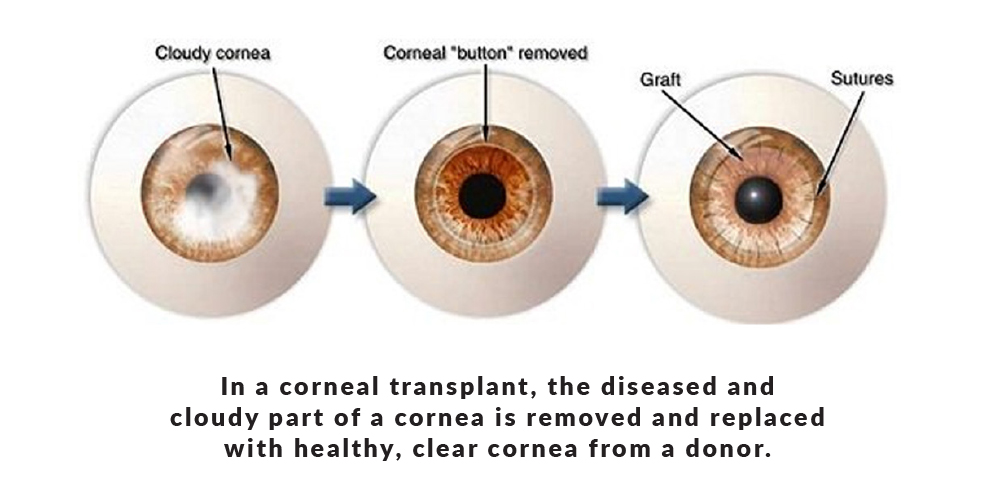
Damaged or diseased corneas can be replaced with healthy corneal tissue in transplants, available at Sunway Medical Centre
People who wax lyrical about the eyes being the window to the soul may not know there literally is a “window” that works to enable vision. It is the cornea, the clear outer surface of the eye that helps focus light so we can see clearly. Injury, infection or disease can damage it, leading to scarring, which blocks or distorts light as it enters the eye. Corneal clouding or scarring can result in glare or blurred vision.
The good news is that a damaged or diseased cornea can be replaced
with a healthy one to improve sight, relieve pain and treat severe infection. Keratoplasty, or a corneal graft, involves removing the damaged part and replacing it with donated corneal tissue.
Corneal transplants are available at Sunway Medical Centre and ophthalmologist Dr Chan U-Teng, who subspecialises in cornea and external eye diseases, explains why they are carried out, what is involved, the risks patients face and the outcomes.
“Certain cornea diseases can be treated with transplants but we have to assess the problem first,” she says. There are four categories of such procedures.

The first is optical — to restore vision when there is a scar or an abnormal curvature on the cornea, which prevents clear vision. Second, if the cornea is perforated, a tectonic graft is carried out to cover up the hole and strengthen ocular integrity. Perforations can be caused by disease or infection.
Therapeutic transplants are undertaken to treat ongoing infections that do not respond to medication. In cases where the bacteria or fungus causes damage fast, perforations can occur.
A therapeutic transplant removes the infected area and replaces it with healthy corneal tissue.
In instances where a damaged cornea does not have much visual potential, a transplant may still be carried out to give the appearance of a normal eye. However, owing to the shortage of donors, the better option is to look at other ways of restoring the cosmetic look of the eye, Dr Chan adds. “We can use an ocular prosthesis or a cosmetic contact lens, which gives the appearance of a real eye.”
There are different types of cornea grafting too. A full thickness transplant involves removing the full cornea, especially when it is scarred, because should any part of the scar remain, it can impede vision.
Transparency or clarity of the cornea is maintained by a layer of cells, which stop functioning if they are diseased. The cornea will be swollen and it is no longer transparent, Dr Chan explains. In such cases, only the diseased part of the cornea is removed and replaced with a similar structure from a donor. The normal part is retained and, eventually, any swelling will subside and vision will improve.
A corneal transplant can take from one to two hours, depending on the complexity of the surgery. To prepare, the surgeon will optimise any medical issue the patient may have. If he has diabetes, it has to be under control, otherwise the wound would heal slowly and be prone to infection. Preoperative investigations involve blood tests, an X-ray, an ECG and now, a Covid-19 test too.
Patients must understand what they are looking at, such as the period of visual rehabilitation, what they can or cannot do post-op, and watch out for signs of transplant rejection.
Eye drops are necessary in the initial period after surgery; in some cases, they will be a life-long need. Patients will be given an eye shield to wear for a couple of months. They are discouraged from lifting heavy objects or strenuous exercise because when the wound is healing, the eye is still very weak. Straining the body can cause the stitches to give way or the wound to open. There are no dietary restrictions unless the patient has some medical issues.
What are the risks and complications of corneal grafting? If the transplant is to improve vision, the risk would be graft rejection — the body cannot accept the cornea put in. When this happens, the cornea becomes swollen and there will be loss in transparency. Sometimes, the transplanted cornea fails to thrive or function normally. Again, the signs are a swollen cornea and poor vision.
Infection may occur after surgery. If it is severe, it could result in blindness. Pressure in the eye can also increase following a transplant. When the pressure affects the optic nerve, which connects the eye to the brain, it can lead to glaucoma.
Retinal detachment is another possible complication. The retina is a layer at the back of the eye that is important for vision. Sometimes during or after surgery, the retina can detach. If that happens, the surgeon may have to resort to a second operation to correct the problem.
At the back of the eye is a layer full of blood vessels. During surgery, this very vascular layer may start bleeding. If that occurs — on average, one in a thousand cases — it is the worst-case scenario because it will ultimately lead to blindness.
Symptoms of graft rejection include a red eye, pain and blurring of vision. Infection can present the same way too. Patients will be told to watch out for these signs and if they spot any, they need to go to the hospital and see the ophthalmologist straight away.
The outcome of a transplant depends on why it is done in the first place. “The outcome is fairly good in optical indication, whereas for infection, it is guarded. Sometimes, what we want is to heal the infection but the vision may be compromised,” Dr Chan says.
Corneas are harvested from donors after they have been declared dead, ideally within six hours of death. Before any surgery, the donor is screened for Hepatitis B and C, HIV and syphilis. The donor cornea is also checked to ensure it is transparent and clear, with enough cells to maintain its quality before it is sent where needed.
After the eyeball has been removed from a deceased, he/she will have a sunken look. “The surgeon will reconstruct the socket by inserting a prosthesis and suturing back the eyelid to create a normal appearance,” Dr Chan explains.
Corneas are in short supply in Malaysia and most of what is available locally is reserved for emergency cases, such as perforations or infections. People do pledge to be donors but upon death, their next-of-kin have to give their consent before the harvesting procedure can be carried out. Therefore, those who want to donate should inform their family of their wishes.
There is no age limit for donors. Even children can do so because eyeballs attain adult size by the age of two. Even those who are long- or short-sighted can donate too, as long as the cornea is clear, with no infectious disease.
“Corneas are precious,” Dr Chan says. If they are not used for a full transplant, they can be utilised in optical or tectonic grafts. After an eyeball is removed, its back portion is kept for other surgical purposes.
Sunway Medical Centre gets its donor corneas from the eye bank in Seattle, US.
Once an order is placed, the corneas are placed in Optisol, a storage medium with the nutrients they need to survive while being transported. “They reach us in very good condition,” she adds.

